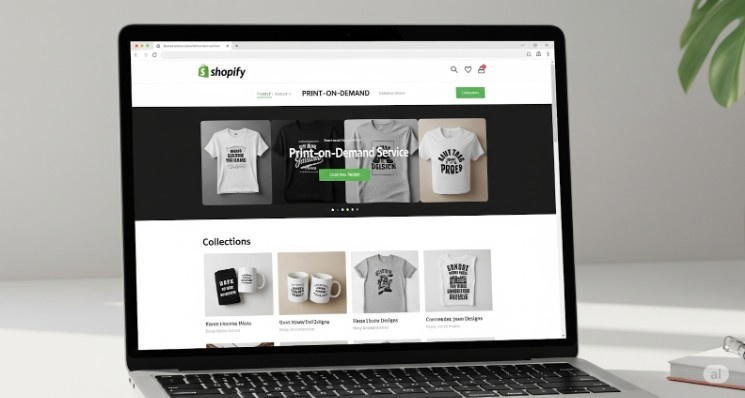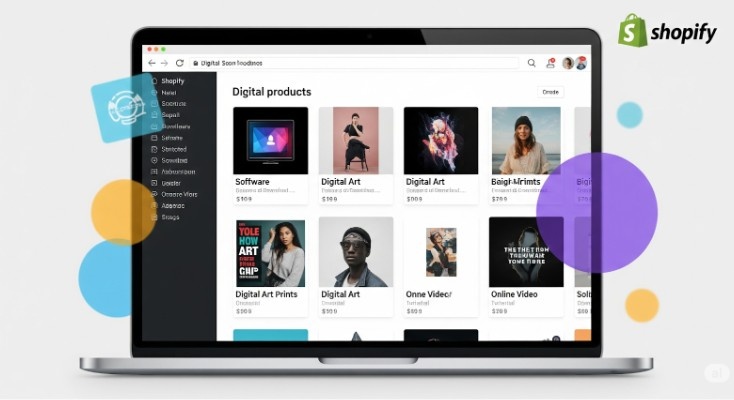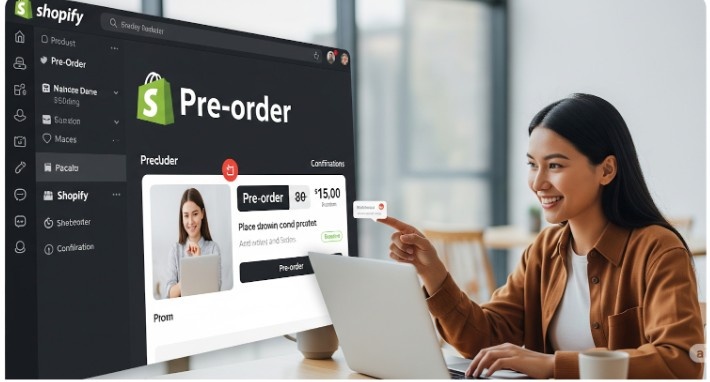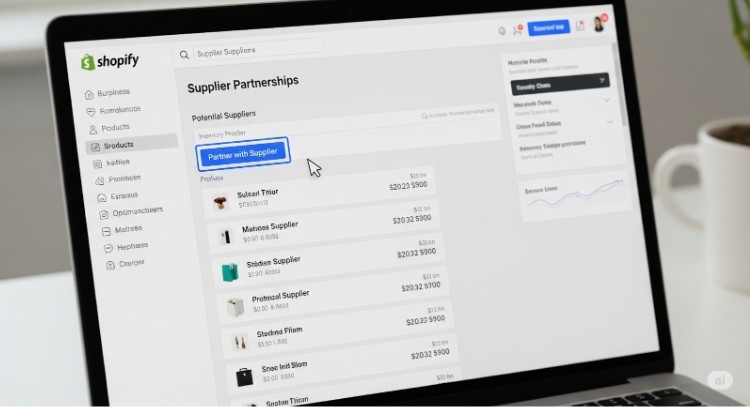You can sell on Shopify without inventory through dropshipping, print-on-demand, digital products, pre-orders, and supplier partnerships. These business models eliminate upfront inventory costs while maintaining profitability.
Starting an online business has never been more accessible, but the traditional model of buying inventory upfront can be intimidating for new entrepreneurs. I’ll walk you through proven strategies to build a successful e-commerce business without inventory investment, covering everything from dropshipping to digital products and beyond.
Do You Need Inventory To Sell On Shopify?
You don’t need inventory to sell on Shopify. The platform supports multiple business models, including dropshipping, print-on-demand, digital products, and affiliate marketing, that eliminate inventory requirements completely.

You can sell virtually any legal product on Shopify without inventory, provided you find reliable suppliers or service providers. The key limitation is finding partners who can fulfill orders professionally.
How To Sell My Product Without Inventory On Shopify?
You can sell products without inventory by partnering with suppliers who handle fulfillment directly. Here are the main strategies that successful entrepreneurs use to generate revenue without upfront inventory investment.
| No | Method | What is it? |
|---|---|---|
| 1 | Dropshipping on Shopify | Partner with suppliers who handle inventory and ship products directly to customers upon order. |
| 2 | Print-on-Demand Services | Sell custom-designed products that are printed and shipped only when customers place orders. |
| 3 | Digital Products | Create and sell downloadable content like ebooks, courses, and templates with instant delivery. |
| 4 | Pre-Orders | Allow customers to purchase products before manufacturing to validate demand and secure funding. |
| 5 | Partnering with Suppliers | Collaborate with manufacturers who manage inventory while you focus on marketing and sales. |
Now, let’s get into detail and see how these methods work and what the pros and cons of each of them are:
1. Dropshipping on Shopify
Dropshipping involves partnering with suppliers who store, package, and ship products directly to your customers upon receipt of an order. You list products on your Shopify store, and when customers purchase, your supplier fulfills the order while you earn the profit margin.

You can find inspiring Shopify case studies that demonstrate how entrepreneurs have built profitable stores without ever touching inventory.
To get started with dropshipping, research reliable suppliers through platforms like AliExpress or Oberlo, focusing on products with a 3-5x markup potential and fast shipping times.
Most entrepreneurs start with $500-$ 2,000 for store setup, marketing, and essential tools, with potential monthly earnings ranging from $ 1,000 to $10,000+, depending on your niche selection and marketing effectiveness.
2. Print-on-Demand Services On Shopify
Print-on-demand allows you to sell custom-designed products like t-shirts, mugs, and phone cases without holding inventory. When customers order, the POD service prints your design on the product and ships it directly to them.

According to recent Shopify statistics, print-on-demand stores represent a substantial portion of new merchant signups.
Success in print-on-demand requires creating unique designs using tools like Canva or hiring freelance designers, then partnering with services like Printful or Gooten.
Target specific niches with passionate audiences, starting with an initial investment of $200-1,000 for design tools, store setup, and initial marketing, with potential monthly earnings of $500-5,000+ based on design quality and marketing reach.
3. Digital Products On Shopify
Digital products include e-books, online courses, software, templates, and downloadable content that customers receive instantly after making a purchase. This model offers the highest profit margins since there’s no physical production or shipping involved.

Understanding Shopify’s market share can help you appreciate the platform’s reach and potential for digital product sales.
The key to digital product success lies in identifying your expertise area and creating valuable content that addresses specific problems, using apps like Digital Downloads for seamless delivery.
Focus on evergreen topics with consistent demand, beginning with just $100-500 for content creation tools and marketing, with potential monthly earnings of $1,000-20,000+, offering scalable passive income potential.
4. Pre-orders on Shopify
Pre-orders allow customers to purchase products before they’re manufactured or available for shipping. This strategy helps gauge demand, secure funding for production, and build anticipation for new product launches.

Starting with pre-orders means validating product concepts through surveys and social media engagement while setting realistic delivery timelines and communicating transparently with customers.
Use pre-order apps for automated management with an initial investment of $300-1,500 for prototyping and marketing campaigns, potentially earning $2,000-15,000+ monthly depending on product appeal and market validation.
5. Partnering with Suppliers On Shopify
Supplier partnerships involve collaborating with manufacturers or wholesalers who handle inventory and fulfillment while you focus on marketing and sales. This hybrid approach combines the benefits of inventory management with reduced management responsibilities.

Shopify B2B capabilities make it easier to manage wholesale relationships and bulk orders through supplier partnerships.
Building successful supplier partnerships requires attending trade shows and using platforms like Alibaba to find manufacturers offering fulfillment services, then negotiating favorable terms and establishing clear communication channels.
Expect to invest $1,000-5,000 initially for samples, legal agreements, and initial marketing, with potential monthly earnings of $3,000-25,000+ once you establish strong supplier relationships and effective marketing strategies.
More Ways For Shopify Business Without Inventory
Beyond traditional product sales, numerous service-based and digital opportunities exist for inventory-free businesses. These alternative approaches can generate substantial revenue while leveraging your existing skills and expertise.
1. Memberships
Membership sites offer exclusive content, community access, or ongoing services for recurring fees. You can sell gym memberships, educational content access, or premium community features through your Shopify store using membership apps and recurring billing features.
2. Consultations
Professional consultations leverage your expertise to help clients solve problems or achieve goals. Whether you’re a business coach, fitness trainer, or marketing specialist, Shopify’s booking apps and payment processing make selling consultation services straightforward and profitable.
3. Digital Downloads
Creative professionals can sell digital assets like photography, design templates, music tracks, or educational materials. Customers receive instant downloads after purchase, eliminating shipping costs while providing immediate value and generating passive income from your creative work.
4. Adventures
Experience-based businesses can sell adventure packages, tours, or unique experiences through Shopify. From local city tours to exotic travel packages, you can market and sell experiential products that create lasting memories for customers.
Steps To Start Selling On Shopify Without Inventory
Starting your inventory-free Shopify business requires strategic planning and systematic execution. Follow these essential steps to launch your store successfully and avoid common pitfalls that derail new entrepreneurs.
1. Choose Your Business Model
Research different inventory-free models to find the best fit for your skills, interests, and target market. Consider factors like startup costs, time investment, and profit potential when making your decision.
2. Set Up Your Shopify Store
Create your Shopify account using the free trial, select a professional theme, and customize your store’s design to reflect your brand identity and appeal to your target customers. Many successful merchants have started this way, as evidenced by numerous top Shopify stores that began as small inventory-free operations.
3. Find Reliable Suppliers (Dropshipping/Print-on-demand)
Research potential suppliers thoroughly, order samples to test quality, and verify their reliability, shipping times, and customer service standards before committing to partnerships.
4. Add Products To Your Store
Create compelling product listings with high-quality images, detailed descriptions, and competitive pricing that highlight benefits and address customer concerns to maximize conversion rates.
5. Set Up Payment Gateways
Configure multiple payment options, including credit cards, PayPal, and digital wallets to accommodate customer preferences and reduce checkout abandonment rates.
6. Promote Your Store
Develop a comprehensive marketing strategy using social media, content marketing, email campaigns, and paid advertising to drive traffic and generate your first sales.
Shopify Pricing Plans Comparison
Shopify offers a World-class checkout system (converts 15% better than competitors), In-person selling capabilities with Shopify POS, Multiple sales channels (Instagram, TikTok, Google), analytics and reporting, and Access to the Shopify app store with their plans.
Here is the detailed pricing of Shopify to help you understand which one suits you better:
| Plan | Monthly Price | Annual Price |
|---|---|---|
| Basic | $39/month | $29/month |
| Grow | $105/month | $79/month |
| Advanced | $399/month | $299/month |
Basic Plan: Perfect for solo entrepreneurs just starting out. Includes essential ecommerce features, 77% shipping discounts, 10 inventory locations, and 24/7 support for building your first online store.
Grow Plan: Designed for small teams ready to expand. Offers enhanced shipping discounts (88%), five additional staff accounts, and improved transaction rates for growing businesses.
Advanced Plan: Built for scaling businesses with complex needs. Features enhanced support, local storefronts, 15 staff accounts, and the lowest transaction rates for high-volume operations.
For detailed insights into how this plan compares to enterprise solutions, check out our Shopify Advanced vs Plus comparison.
Advantages Of Selling Without Inventory
Inventory-free selling offers numerous benefits that make it attractive for both new entrepreneurs and established businesses. Understanding these advantages helps you leverage the model’s strengths for maximum success.
1. Lower financial risk: Starting without inventory eliminates the risk of unsold products, reducing potential losses and making entrepreneurship accessible to those with limited capital.
2. Faster market entry: You can launch your business quickly without waiting for inventory procurement, allowing you to test markets and validate ideas rapidly.
3. Global scalability: Without physical inventory constraints, you can serve customers worldwide and scale operations without limitations on warehouse capacity or shipping infrastructure.
4. Focus on core business: Eliminating inventory management allows you to concentrate on marketing, customer service, and business growth, rather than logistics and storage challenges.
5. Flexibility and adaptability: You can quickly pivot products, test new niches, or adjust offerings based on market demand without being stuck with unsold inventory.
Disadvantages of Selling Without Inventory
While inventory-free models offer many benefits, they also present unique challenges that require careful consideration and strategic planning to overcome successfully.
1. Reduced profit margins: Third-party fulfillment and supplier fees typically result in lower profit margins compared to buying and stocking inventory in bulk quantities.
2. Less quality control: Relying on suppliers for product quality and fulfillment can lead to customer dissatisfaction if standards are not consistently met.
3. Supplier dependency: Your business success depends heavily on supplier reliability, making you vulnerable to their operational issues, delays, or policy changes.
4. Intense competition: Popular inventory-free niches often have many competitors, making differentiation and customer acquisition more challenging and expensive.
5. Complex customer service: Handling returns, refunds, and customer complaints becomes more difficult when you don’t directly control the fulfillment process.
Tips For Selling Without Inventory On Shopify
Success in inventory-free selling requires specific strategies and best practices. These proven tips will help you build a profitable business while avoiding common mistakes.
1. Research your niche thoroughly: Identify underserved markets with strong demand but limited competition to maximize your chances of success and profitability.
2. Choose reliable partners: Invest time in finding trustworthy suppliers and service providers who align with your quality standards and business values. Reading reviews can help you make informed decisions about suppliers and tools.
3. Optimize for search engines: Focus on SEO optimization to drive organic traffic and reduce dependency on expensive paid advertising for customer acquisition.
4. Build strong customer relationships: Prioritize excellent customer service and communication to build trust and encourage repeat purchases despite not controlling fulfillment.
5. Monitor performance metrics: Track key performance indicators like conversion rates, customer acquisition costs, and supplier performance to optimize your business continuously.
Having easy access to your analytics through your store login dashboard helps maintain consistent monitoring.
Conclusion- Inventory-Free Shopify Success Is Achievable
Building a profitable Shopify store without inventory is not only possible but can be highly lucrative with the right strategy.
If you choose dropshipping, print-on-demand, digital products, or service-based offerings, success depends on thorough market research, reliable partnerships, and excellent customer service.
Start with one model that matches your skills and interests, then scale and diversify as you gain experience and build your customer base.
FAQs
You can start with as little as $29 monthly for Shopify’s basic plan plus domain costs, making it very affordable for beginners.
Many successful stores combine dropshipping, digital products, and services to diversify revenue streams and reduce risk.
Most stores see first sales within 30-90 days, but consistent profitability typically takes 6-12 months of focused effort.
While not required, apps like DSers for dropshipping or Printful for print-on-demand significantly streamline operations and automate processes.
You’re still responsible for sales tax collection and income tax reporting, regardless of whether you hold inventory or not.

